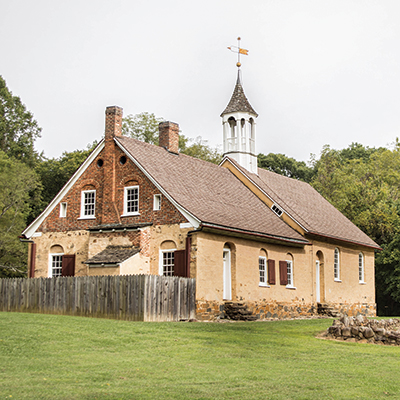The Gemeinhaus
1754 Reconstructed Village | The Palisade | The Log House | The Brewer’s House | The Potter’s House | The Gemeinhaus
 The 1788 Gemeinhaus Church, the last eighteenth-century German church with attached living quarters remaining in the United States, furnished with period furniture, some original to the building.
The 1788 Gemeinhaus Church, the last eighteenth-century German church with attached living quarters remaining in the United States, furnished with period furniture, some original to the building.
And to Him we
sound forth praise,
That within this building holy
We may seek
through all our days
Strength to love and serve Him solely
(From the musical ode consecrating the building)
The crown jewel of Historic Bethbara Park is the restored 1788 Gemeinhaus. The Gemeinhaus was not only a church but also a meeting place, school, and minister’s house for the settlement. It is the only German colonial church with attached minister’s living quarters remaining in the United States. It is furnished with period furniture, some original to the building, and a reconstructed Bulitschek organ. The Saal of the Gemeinhaus was a place of reflection and prayer. Seating in the Saal depended on your age, gender, and marital status.
The church, call the “Gemeinhaus” even in the earliest records of the community of Bethabara, served as a residence for the minister and other church workers and had a “Saal” – a “meeting hall” – for the congregation; the most accepted translation of “Gemeinhaus” being “congregation house.” Built in 1788, the current Gemeinhaus replaced an original log structure built in 1756 that was located elsewhere on the Bethabara grounds.
The “Lot” decided the exact location of the 1788 Gemeinhaus. This is a method of decision making employed by the early Moravians on many aspects of life: several possible solutions to a question are placed in a hat and the one selected was prayerfully respected as the Lord’s decision.
A quote from the Moravian records:
“The Saviour approves that the Gemeinsaal in Bethabara should be built along the street in Stach’s garden.”
The architect for the project, Frederic William Marshall, submitted plans on January 4, 1788 and, with the whole congregation in attendance, the foundation stone was laid April 8, 1788. Both Moravian and non-Moravian workers were hired; Moravians were paid 9 shillings and non-Moravians 8 shillings, with room and board provided.
With only eighteen families in the Bethabara congregation, the minister, Jacob Ernst, requested financial help from the Moravian congregations in Pennsylvania to allow the church to be completed without going into debt; however, no help was received.
Stone was quarried from a farm south of town and the timbers fashioned using broadaxe and adz. Yellow poplar shingles, leftover from the recent construction of a distillery across the street, were used on the roof. The gutters, also made of yellow popular, were tarred on the inside and painted red on the outside.
Consecration of the Bethabara Gemeinhaus took place on November 26, 1788, though there seems to be no reason for this date other than convenience of schedule. The fact that it is close to November 17, the date from thirty-five years earlier when the first Moravians arrived in Wachovia, seems to hold more interest to us today that it did the early Moravians, – the Church fathers apparently put more store in spiritual history that in the events of hardship or accomplishment.
The 1788 Gemeinhaus served the Bethabara Moravian congregation until 1953, fully two hundred years after the founding of the community. The new, replacement church was built at the intersection of Bethabara Road and Indiana Boulevard.
Excavation of the original foundation of Bethabara occurred in the mid-1960s. Restoration of the Gemeinhaus took place in 1969-70 and the restored Gemeinhaus and the new Historic Bethabara Park were dedicated on Sunday, April 25, 1971. Today, employees of the Winston-Salem Recreation and Parks Department serve as administrators.
The Rooms
The School room: The schoolroom was used for other purposes also, such as the making of love-feast coffee. The school, itself, moved out of the Gemeinhaus in 1805.
The Parlor: The front room was the minister’s parlor in the early days of the Gemeinhaus. By 1849, the “parlor” had moved to the old school room in the back of the structure.
The Upstairs Bedroom: The upstairs bedroom was used for visiting church workers. Strangers (non-Moravians) never stayed in the Gemeinhaus, instead being housed in the tavern. (The rest of the upstairs was used for storage of church equipment, such as the gravedigger’s tools and personal property of the minister.)
The Kitchen, Saal, and Downstairs Bedroom: These rooms were always used as their names imply. In a more modern era, the back wall of the Saal was removed to enlarge the size of the sanctuary; it was replaced during the most recent renovation.
